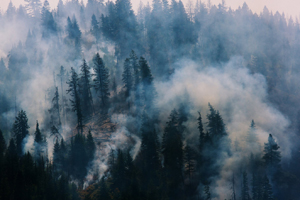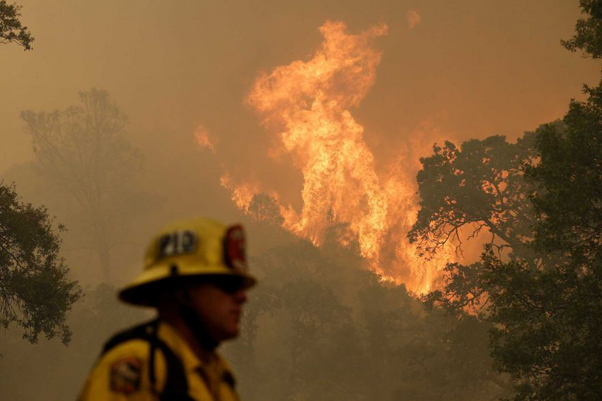DesalData Weekly - August 26, 2015
Posted 26 August, 2015 by Mandy
 For the first time since 2013, the U.S. entered “National Preparedness Level 5”—a term that signifies “all agency fire resources” across the country are nearly exhausted and struggling to fight fires. At present, vast infernos are raging across Northern California and the Northwest.[1] The severe drought and heat across the region is creating one of the worst “wildfire summers” on record. Last week, fire officials reported the situation could worsen “with a new round of wind and heat.”[2] The New York Times reports that more acres have burned this year so far – 7.2 million as of last week – than in each of the previous 10 years.[3] Alaska has suffered the great majority of these conflagrations, but California is currently dealing with the worst of them.
For the first time since 2013, the U.S. entered “National Preparedness Level 5”—a term that signifies “all agency fire resources” across the country are nearly exhausted and struggling to fight fires. At present, vast infernos are raging across Northern California and the Northwest.[1] The severe drought and heat across the region is creating one of the worst “wildfire summers” on record. Last week, fire officials reported the situation could worsen “with a new round of wind and heat.”[2] The New York Times reports that more acres have burned this year so far – 7.2 million as of last week – than in each of the previous 10 years.[3] Alaska has suffered the great majority of these conflagrations, but California is currently dealing with the worst of them.
Ecologists and historians have identified a long-established link between “megafires” (those that burn more than 100,000 acres) and the gradual loss of moisture in forests.[5] Extended periods of rain are necessary to reduce the risk and fury of these big fires. Warmer and drier weather patterns not only exacerbate ongoing drought, but also intensify and lengthen the fire season, which will last through September in the U.S. The director of the National Park Service, Jonathan Jarvis, has said the agency is adapting to a “new reality of wild variations in climate and larger, more intense blazes, which have already begun to alter the composition of some landscapes.”[6]
The numbers are daunting. This June, there were 400 fires burning across Alaska. In June 2004, the state’s worst fire year on record, there were 200 fires. Across the U.S. last year, 63,312 wildfires destroyed 3.6 million acres of land, and cost $1.52 billion (USD) in firefighting resources. [7] This year’s fires are considerably worse and there is a projected shortage of $600,000 to quell them (which exceeds the allotted $1.5 billion set aside by federal departments). The Republican leadership in Congress has yet to endorse the Obama administration’s requests for a dedicated disaster fund for wildfires (which they asked Congress to place “in the same category as hurricanes and floods.”)[8]

Cal Fire Engineer Johnny Miller below a fire near Lower Lake, Calif. on July 31, 2015 (Credit: Jeff Chiu/AP)[9]
In related news, perhaps equally grim, scientists report that global warming caused by human emissions have significantly intensified the drought in California.[10] Natural climate variability has been the main source of the drought, but climate change increases the probability for a drought to turn into an acute drought. This may, in turn, affect the future of water management, including desalination and reuse throughout the western U.S. The authors of the paper, published in Geophysical Research Letters, report:
Precipitation is the primary driver of drought variability but anthropogenic warming is estimated to have accounted for 8–27% of the observed drought anomaly in 2012–2014 and 5–18% in 2014. Although natural variability [in climate] dominates, anthropogenic warming has substantially increased the overall likelihood of extreme California droughts.”[11]
The paper’s analysis of the relationship between human emissions and drought is reportedly the most exhaustive and thorough research on the subject.[12] Its importance cannot be overstated. On the day of the study’s publication, the National Oceanic and Atmospheric Administration reported that the average global temperature for July—“climatologically the warmest month of the year globally”—was the highest among all 1,627 months of record-keeping that began in 1880.[13]
[1] “National Preparedness Level Definitions,” National Interagency Fire Center, <http://www.nifc.gov/nicc/logistics/references/Definition_of_PL_Levels.pdf> accessed August 25, 2015.
[2] Kirk Johnson and Fernanda Santos, “Western Wildfires Consume Manpower and Acreage,” August 20, 2015, New York Times, <http://www.nytimes.com/2015/08/21/us/3-firefighters-die-in-crash-on-way-to-washington-state-blaze.html?_r=1> accessed August 25, 2015.
[3] Ibid. The Times reports these statistics are compiled by the National Interagency Fire Center.
[4] Photo Credit: see <http://www.nytimes.com/2015/08/02/us/dry-days-in-west-bring-ferocious-start-to-fire-season.html>.
[5] Fernanda Santos, “Dry Days Bring Ferocious Start to Fire Season,” August 1, 2015, New York Times, <http://www.nytimes.com/2015/08/02/us/dry-days-in-west-bring-ferocious-start-to-fire-season.html> accessed August 22, 2015.
[6] See Santos, “Dry Days,” NYT; and Rachel Estabrook, “Climate Change Causing National Park Service to ‘Rethink’ Wilderness Management,” Colorado Public Radio, <http://www.cpr.org/news/story/climate-change-causing-national-park-service-rethink-wilderness-management> accessed August 25, 2015.
[7] Fernanda Santos, “Dry Days,” NYT.
[8] Ibid.
[9] Jeff Chiu and Haven Daley, “Firefighter Killed, 2 Dozen Homes Burn in California Fires,” August 5, 2015, Houston Chronicle, < http://www.chron.com/news/science/article/Firefighter-killed-hundreds-flee-as-California-6418957.php#photo-8393451> accessed August 25, 2015.
[10] Justin Gillis, “California Drought Is Made Worse by Global Warming, Scientists Say,” August 20, 2015, New York Times, <http://www.nytimes.com/2015/08/21/science/climate-change-intensifies-california-drought-scientists-say.html?_r=0> accessed August 25, 2015.
[11] A. Park Williams et al. “Contribution of Anthropogenic Warming to California Drought During 2012-2014,” August 20, 2015, Geophysical Research Letters, <http://onlinelibrary.wiley.com/doi/10.1002/2015GL064924/full> accessed August 25, 2015.
[12] Gillis, “California Drought,” NYT.
[13] Ibid. For further information see “Global Analysis – July 2015,” Temperature Anomalies Time Series, National Centers for Environmental Information (NOAA), <http://www.ncdc.noaa.gov/sotc/global/201507> accessed August 25, 2015.
